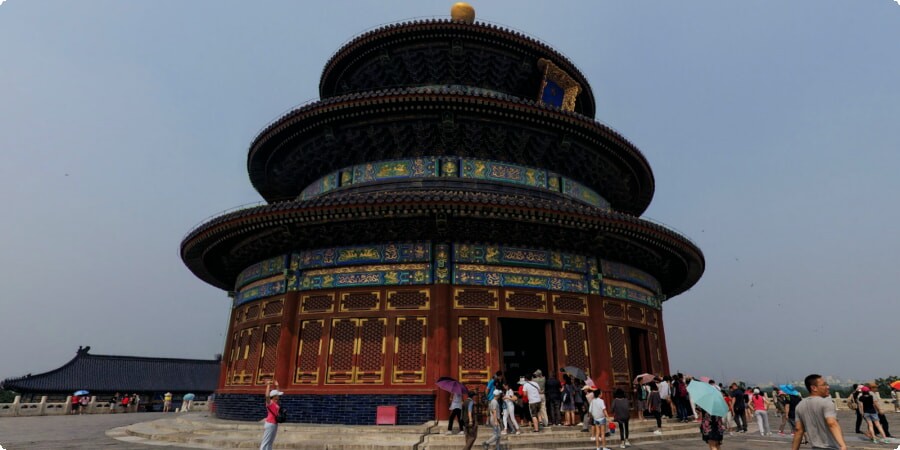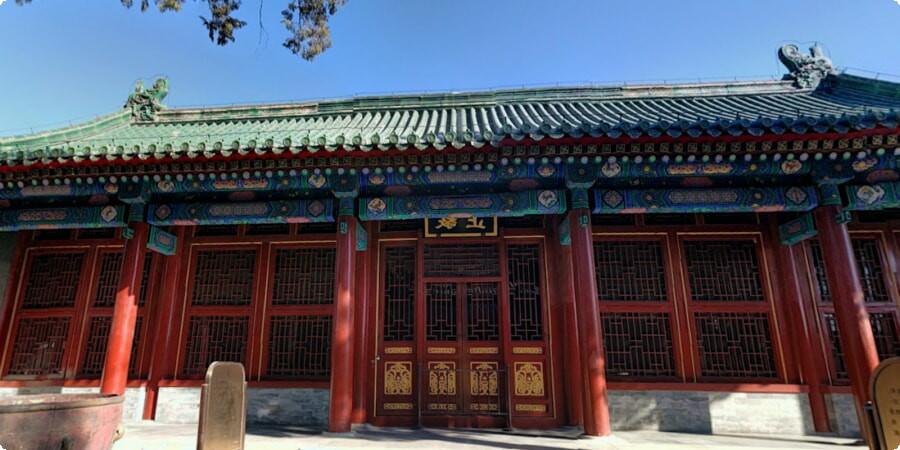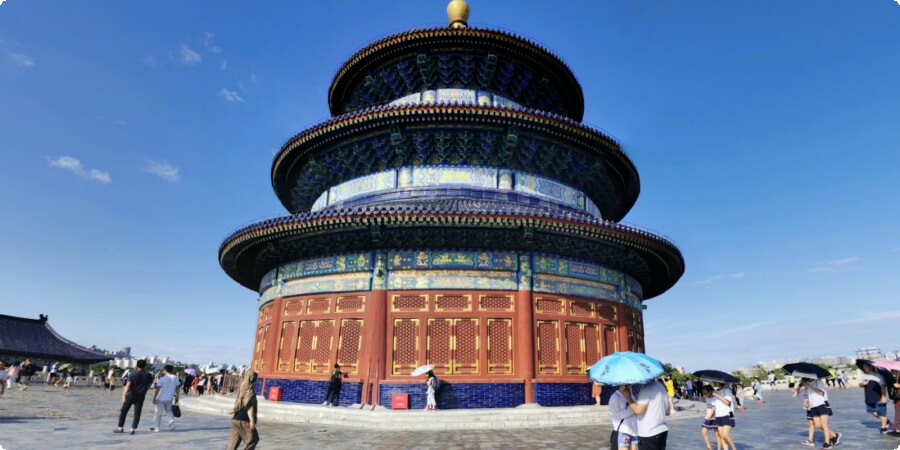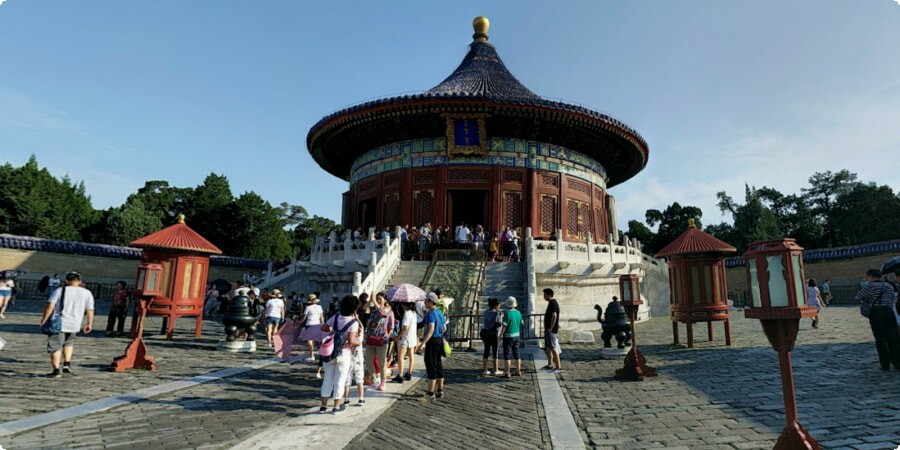The Architectural Wonders of The Temple of Heaven: A Traveler’s Guide
Nestled in the bustling heart of Beijing, the Temple of Heaven stands as a monumental testament to China’s rich cultural heritage and architectural brilliance. As one of the largest and most significant imperial complexes in the world, this sacred site has captured the imagination of countless visitors with its harmonious design and profound spiritual significance. Built during the early 15th century, the temple was a place where emperors of the Ming and Qing dynasties performed solemn rituals to honor the heavens and ensure good harvests.
The Temple of Heaven is not just an architectural marvel; it is a profound representation of ancient Chinese cosmology, where every element of its design serves a symbolic purpose. From its vast circular structures to the meticulous arrangement of its buildings, the temple embodies the ancient Chinese belief in the harmony between heaven and earth. For travelers seeking to immerse themselves in the spiritual and historical essence of Beijing, the Temple of Heaven offers an unparalleled journey through time, art, and tradition.
A Historical Overview: Origins and Purpose
The origins of the Temple of Heaven date back to the early 15th century, specifically to the reign of the Yongle Emperor of the Ming Dynasty, who was also responsible for constructing the Forbidden City. Originally known as the Temple of Heaven and Earth, it was later renamed to reflect its more focused purpose: to serve as the primary venue for imperial ceremonies dedicated to Heaven. Emperors would visit the temple complex annually to perform sacred rituals, most notably the Winter Solstice Ceremony, in which they would pray for bountiful harvests and the well-being of the empire.
The temple’s design reflects the dual influences of Confucianism and Taoism, with its layout embodying the philosophical concepts of harmony and balance. The circular and square elements of the complex symbolize heaven and earth, respectively, illustrating the ancient Chinese view of the cosmos as a delicate balance between these two forces. The temple was meticulously aligned with the cardinal directions, and its construction incorporated principles of Feng Shui to ensure that the site was in perfect harmony with the natural environment. This deep intertwining of architecture and spirituality makes the Temple of Heaven a place of profound historical and cultural significance.
For visitors wanting to delve deeper into the rich history and purpose of the Temple of Heaven, consider taking a guided tour that explores the lesser-known aspects of the complex. To make your visit even more convenient, it's a good idea to book a car at Beijing Airport to easily access the temple and other key attractions around Beijing.

Architectural Significance: A Masterpiece of Ming Design
The architectural splendor of the Temple of Heaven lies in its exquisite balance of form, function, and symbolism. Designed according to strict Ming Dynasty architectural principles, the temple complex covers an area of 2.73 square kilometers, nearly four times the size of the Forbidden City. The layout is divided into two main sections: the northern circular section representing heaven, and the southern square section symbolizing earth. This intentional design mirrors the traditional Chinese concept of "Round Heaven, Square Earth" (天圆地方), which reflects the ancient belief in a flat earth beneath a round sky.
The temple’s most iconic structure, the Hall of Prayer for Good Harvests, is a striking circular building made entirely of wood, without the use of nails. Standing at 38 meters tall and 36 meters in diameter, the hall features a triple-gabled roof adorned with blue tiles, which symbolize the color of the sky. Inside, the hall is supported by four inner pillars, known as the Dragon Well pillars, representing the four seasons, and twelve outer columns, symbolizing the months of the year. This harmonious use of numbers and spatial design showcases the Ming architects’ deep understanding of cosmology and their desire to create a space that resonated with the heavens.
Another architectural marvel within the complex is the Circular Mound Altar, a three-tiered white marble platform that was used for the annual winter solstice ceremony. The altar’s circular shape and its series of concentric rings reflect the belief in the perfection and infinity of heaven. Visitors standing in the center of the top tier can experience a unique acoustic phenomenon where their voice resonates clearly, symbolizing the connection between earth and heaven.
For those keen to explore the architectural nuances of the Temple of Heaven, visiting the complex offers a chance to step into a world where every structure, every color, and every detail has been carefully chosen to reflect the grandeur and philosophy of ancient China. Don’t forget to bring a camera and capture the stunning symmetry and detail that have made this site a symbol of Beijing’s historical and cultural landscape. To find the Temple of Heaven on your map, you can easily locate it on Google Maps.

The Role of the Temple of Heaven in Imperial Ceremonies
The Temple of Heaven was not just a physical structure but also a central stage for elaborate imperial rituals, particularly during the Ming and Qing dynasties. These ceremonies were deeply embedded in Chinese cosmology and imperial ideology, reflecting the emperor's role as the "Son of Heaven." The most significant of these ceremonies was the annual Winter Solstice Sacrifice, where the emperor would personally offer prayers and sacrifices to Heaven, seeking blessings for a prosperous new year and a good harvest.
The rituals were meticulously planned and followed a strict sequence of events, symbolizing the emperor’s duty to maintain harmony between heaven and earth. Dressed in special ceremonial robes, the emperor would lead a procession of court officials and musicians through the temple complex, moving from the Imperial Vault of Heaven to the Circular Mound Altar. Each step, gesture, and offering was laden with symbolic meaning, intended to align the earthly realm with the divine.
Understanding the historical context of these ceremonies adds a deeper layer of appreciation for the site. Today, while the rituals are no longer performed, visitors can still feel the spiritual energy and sense the profound historical significance of the temple grounds. A visit to the Temple of Heaven is not just about observing its architectural beauty; it is also about connecting with the ancient traditions that shaped China’s cultural and spiritual heritage.
The Echo Wall and the Imperial Vault of Heaven: Architectural Marvels
One of the most intriguing features of the Temple of Heaven is the Echo Wall surrounding the Imperial Vault of Heaven. This circular wall is famed for its unique acoustic properties. A whisper spoken against one part of the wall can be clearly heard on the other side, an engineering feat that continues to astonish visitors today. The wall’s design amplifies sound waves, making it a fun and interactive experience for those exploring the temple grounds.
Adjacent to the Echo Wall is the Imperial Vault of Heaven, a small but intricately designed building that once housed the divine tablets used during the sacrificial ceremonies. Like the Hall of Prayer for Good Harvests, the Imperial Vault is circular, symbolizing heaven, and is topped with a blue-tiled roof. It is elevated on a round marble base, further emphasizing its celestial significance. The vault’s design is simple yet elegant, with a symmetrical layout that reflects the Chinese principles of balance and harmony.
For those interested in the technical aspects of ancient Chinese architecture, these structures offer a glimpse into the sophisticated understanding of acoustics and spatial dynamics by Ming Dynasty builders. The experience of standing in these spaces, where emperors once stood, is both humbling and awe-inspiring.
For visitors looking to explore these architectural wonders and more, traveling around China can be made easier by renting a car. This allows for greater flexibility and convenience, especially when exploring areas beyond Beijing. Consider booking a car in China to enhance your travel experience and make the most of your visit.

The Symbolism and Design of the Circular Mound Altar
The Circular Mound Altar is another remarkable structure within the Temple of Heaven complex, notable for its symbolic design and spiritual significance. Built entirely from white marble, the altar is a three-tiered circular platform that represents the ancient Chinese cosmological belief in the sanctity of heaven. Each level of the altar is adorned with meticulously carved balustrades, and the entire structure is designed without the use of nails, a testament to the architectural prowess of the time.
The altar’s design is deeply symbolic: the circular shape represents the heavens, while the three tiers correspond to the three realms of the cosmos—Heaven, Earth, and the Mortal World. The number nine, considered the most powerful number in ancient Chinese numerology and a symbol of the emperor, is also a prominent feature of the altar’s design. The top tier has a central stone known as the Heart of Heaven, where the emperor would stand to communicate directly with the divine.
Visitors today can walk up the steps of the altar and stand at the center, imagining the powerful connection between the earth and the heavens that ancient emperors sought to maintain. The open-air design of the altar, combined with its elevated position, provides a panoramic view of the surrounding temple grounds, enhancing the spiritual ambiance of the site.
Exploring the Circular Mound Altar is a must for anyone interested in the deeper spiritual and philosophical beliefs that shaped the construction of the Temple of Heaven. For those planning their visit, check the weather in advance and plan to visit early in the morning or late in the afternoon to avoid the crowds and experience the altar in a more serene setting.
Seasonal Changes and the Temple of Heaven: Best Times to Visit
The Temple of Heaven, like many landmarks in Beijing, offers a unique experience depending on the time of year. Each season brings its own charm and atmosphere to the temple grounds, making it worthwhile to consider the timing of your visit.
Spring is one of the best times to explore the Temple of Heaven. The ancient cypress and pine trees, which have stood for centuries, start to bloom with vibrant flowers, adding color and life to the surroundings. The weather is mild, making it comfortable for long strolls through the expansive park that surrounds the temple complex. It's a great time for photography, especially in the early morning when the light is soft and the grounds are less crowded.
Summer brings a different vibe to the Temple of Heaven. With lush greenery in full swing, the temple grounds become a popular spot for locals practicing Tai Chi, playing traditional instruments, or engaging in community activities. While the temperatures can rise significantly, visiting in the early morning or late afternoon can help avoid the heat and provide a glimpse into the daily life of Beijing residents.
Autumn is arguably the most beautiful season to visit the Temple of Heaven. The weather is cool and crisp, and the ancient trees turn to shades of gold, red, and orange. This season also tends to be less crowded than summer, offering a more peaceful experience. The serene atmosphere is perfect for those who wish to soak in the historical and spiritual ambiance of the temple.
Winter at the Temple of Heaven has its own stark beauty. The snow-covered grounds create a striking contrast with the deep blue roofs and white marble structures. While it’s cold, the quietness of the season allows for a more contemplative visit, and there are fewer tourists. It's a great time to experience the temple in solitude and imagine it as it might have been centuries ago.
When planning your visit, consider these seasonal changes to enhance your experience. Be sure to check the local weather forecast, and pack accordingly.

Practical Tips for Visitors: What to Know Before You Go
Before embarking on your journey to the Temple of Heaven, there are a few practical tips to ensure you have the best experience possible:
-
Opening Hours and Tickets: The Temple of Heaven opens daily, typically from early morning to late afternoon, with slightly extended hours in summer. There are different ticket options depending on whether you want to visit the entire park or specific sites like the Hall of Prayer for Good Harvests. It's a good idea to check online or at the entrance for the latest ticket prices and opening hours.
-
Getting There: The Temple of Heaven is located in the Dongcheng District of Beijing and is easily accessible by public transport. You can take the Beijing subway to the Tiantandongmen Station (Line 5), which is directly adjacent to the East Gate of the park. Alternatively, several bus routes stop nearby.
-
What to Wear and Bring: Comfortable walking shoes are a must, as the temple grounds are vast, and you’ll likely spend several hours exploring. Depending on the season, bring sun protection like hats and sunscreen in summer or warm clothing in winter. Also, consider bringing a water bottle and some snacks, as there are limited food options within the park.
-
Respect the Cultural Heritage: The Temple of Heaven is not only a tourist attraction but also a site of great historical and cultural significance. Visitors are encouraged to respect the ancient structures and not climb or touch any of the relics. Photography is generally allowed, but it’s always good to check for any restrictions in certain areas.
-
Booking a Car for Convenience: If you prefer flexibility and convenience in your travels, renting a car can be a great option, especially if you plan to explore beyond Beijing. For those interested, consider booking a car in China for an easier and more personalized travel experience.
Connecting with Local Culture: Beyond the Temple Grounds
A visit to the Temple of Heaven provides an excellent opportunity to connect with local culture and the daily life of Beijing residents. The temple grounds are not only a historical site but also a living space where local communities come together to engage in various activities.
In the early mornings, the park around the temple comes alive with locals practicing Tai Chi, a form of martial arts known for its health benefits and meditative movements. Joining a session, or simply observing, can be a calming and culturally enriching experience. Similarly, you might find groups of people playing traditional Chinese instruments, singing, or even practicing calligraphy on the ground with water.
For those interested in photography, these daily activities offer a unique glimpse into the cultural fabric of Beijing, contrasting sharply with the more tourist-centric areas of the city. It’s a chance to see how ancient traditions and modern life blend seamlessly in this historic city.
The Temple of Heaven is also close to several local markets and eateries where you can sample authentic Beijing cuisine. After your visit, consider exploring the nearby Hongqiao Pearl Market or one of the many street food vendors in the area. These experiences provide a fuller understanding of Beijing’s rich culture, far beyond the historical landmarks.
Visiting the Temple of Heaven is more than just seeing an ancient architectural marvel; it’s an opportunity to immerse yourself in the history, culture, and daily life of Beijing. From the magnificent halls and altars to the lively local atmosphere, this site offers a comprehensive experience that resonates with both history enthusiasts and casual travelers alike. Whether you're here for the intricate architecture, the historical significance, or to simply enjoy the peaceful surroundings, the Temple of Heaven has something to offer everyone.